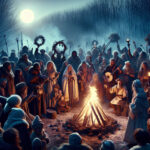Halloween is one of the most popular holidays in the United States and around the world. It’s a time of year when people dress up in costumes and celebrate with friends and family. But did you know that the holiday has pagan roots? In this article, we’ll explore the origins of Halloween, including its pagan name and the traditions it has inspired. We’ll also look at how the holiday has evolved over time and how it is celebrated today. So if you’re curious about the history of Halloween and its pagan name, read on!
Halloween is a holiday celebrated on October 31st each year with costumes, candy and decorations. But, did you know that it has its origins in an ancient pagan celebration? The name Halloween comes from the ancient Celtic festival of Samhain, which marked the end of the harvest season and the start of winter.
What Does Halloween Mean?
The word Halloween is a combination of two words: Hallow and E’en. Hallow is an old English word meaning “holy” or “sacred”. E’en is a contraction of “evening”. So, Halloween literally means the “holy evening”.
What is Samhain?
Samhain is an ancient Gaelic festival that marks the end of the harvest season and the beginning of winter. The festival was celebrated on October 31st, the same day that is now celebrated as Halloween. It was believed that during this time, the boundaries between the living and the dead were blurred and that the spirits of the dead would return to the earth.
What Was Celebrated During Samhain?
During Samhain, the Celts would light bonfires and offer sacrifices to the gods. They also wore costumes, danced and feasted, in celebration of the harvest. In addition, they would light candles to honor their ancestors and the departed.
How Did Samhain Become Halloween?
During the 8th century, the Roman Catholic Church began to incorporate the pagan festivals into their own religious celebrations. They renamed Samhain as All Hallow’s Day, which is now known as All Saints’ Day. The evening before this day was known as All Hallow’s Eve, which eventually became Halloween.
What Are the Traditions of Halloween?
Today, many of the traditions of Samhain still exist in the celebration of Halloween. Costumes, bonfires, and feasts are still popular activities. Trick-or-treating, where children dress up in costumes and go door-to-door for candy, is a modern adaptation of the ancient traditions of offerings and gifts to the gods.
Conclusion
Halloween is a time for fun and celebration, but it also has its roots in an ancient pagan festival. Samhain marked the end of the harvest season and the beginning of winter, and was celebrated with bonfires, costumes, and offerings to the gods. Over the centuries, these traditions have been adapted and changed, but the spirit of Halloween remains the same.
Halloween is an ancient holiday with a long history and many traditions. Its name is derived from the pagan celebration of All Hallows’ Eve, and its roots are firmly planted in the Celtic and Roman cultures. For many, this holiday is a time for fun and festivities, but it is important to remember the origins of the holiday and the ancient traditions that have been passed down through the centuries. Halloween is a time to honor the dead, celebrate the changing of the seasons, and enjoy the festivities with family and friends. It is a time to remember the past, celebrate the present, and look forward to the future.





